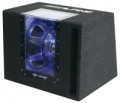Frequency range
The range of audio frequencies reproduced by the subwoofer. It is believed that the human ear is capable of perceiving a frequency range of the order of 16 – 20,000 Hz, but in this case note that the subwoofer is designed to reproduce the lower frequency band (up to 200 Hz). Accordingly, in the case of the lower limit of the range, everything is simple: “the lower, the better”; the upper one should not be lower than the lower limit of the main car audio — otherwise there will be "gaps" in the frequencies, which will affect the sound quality.
Diffuser material
The material from which the speaker cone in the subwoofer is made. Determines the sound quality and, to some extent, the cost of the device.
— Pulp/paper. Historically the first diffuser material. Its advantages are lightness (which ensures high speaker sensitivity), as well as a smooth frequency response (amplitude-frequency response), which positively affects the sound quality. Among the shortcomings — low strength, which limits the power of such subwoofers, as well as softness, somewhat "blurring" the sound in difficult moments. In addition, paper diffusers are sensitive to moisture.
— Polypropylene. Synthetic polymer, in some aspects similar to paper, but differing from it in higher strength and resistance to moisture. It also has a smooth frequency response. Somewhat more cruel, but still belongs to the soft.
— Polyurethane. Another polymer material. At a low cost, it is somewhat stiffer than polypropylene, and is also very resistant to mechanical stress, which allows you to create powerful speakers.
— Kevlar. Kevlar fibre is highly durable (higher than steel); it also has good rigidity, which has a positive effect on fidelity in difficult moments. However, such diffusers are not cheap.
— Carbon fibre. It belongs to premium materials: it has high strength at a very low weight, and in the case of subwoofers, it is also worth mentioning the good rigidity that ensures a clear sound. Among the shortcomings — a somew...hat uneven frequency response and an impressive cost.
— Carbon. Another name used for carbon fibre is mainly for promotional purposes, for brevity and “impressiveness” of sound. See above for more details on carbon fibre.
— Fibreglass. Such material consists of ordinary glass stretched into filaments; unlike the classical form of glass, such threads do not break or break. It's lightweight (respectively sensitive), relatively cheap, resistant to moisture and temperature changes, and still provides good (though not outstanding) sound quality.
— Composite materials. Composite is a material that consists of two or more materials with a clear separation between them. In subwoofer cones, carbon fibre composites (based on carbon fibre, see above) are most often used. Such diffusers have all the advantages of carbon fibre and are able to provide good sound quality — however, due to the characteristics of the frequency response of the material, rather complex electronic circuits have to be used to achieve this quality, which affects, in particular, the price of subwoofers.
— Aluminium. Aluminium cones have the highest rigidity of all, which ensures high fidelity of sound transmission even in difficult moments. The "reverse side of the coin" in this case are their own extraneous "ringing" that occurs in the diffuser. To eliminate them, you have to use various tricks that significantly complicate the design and increase the price of the subwoofer.
Note that each material has its own characteristics and shades of sound, which you should pay attention to when choosing — a more expensive and high-quality material will not necessarily give a sound that you personally will like more.
Material
— MDF. Abbreviation for medium density fiberboard, i.e. medium density fibreboard. This material is inexpensive, easy to process and has a uniform structure, which is important for speaker cabinets. As a result, most modern cabinet subwoofers are made from MDF.
— Resin. It is used in cases where a complex shape is needed, which is difficult to reproduce when using MDF, as well as in compact models (see "Body shape"). In addition, it has no significant advantages over MDF, and therefore is used very rarely.
— Aluminium. Aluminium is light, homogeneous, and also conducts heat well, which allows you to install powerful speakers in such cases without fear of overheating. In addition, it has an elegant appearance. On the other hand, such cases cost accordingly.
— Plastic. Relatively inexpensive and easy to process material, which, at the same time, is available in different grades and may have different properties. Due to this, plastic enclosures are found in both relatively inexpensive and fairly advanced subwoofers; the sound quality of such a subwoofer depends mainly on its general price category.

